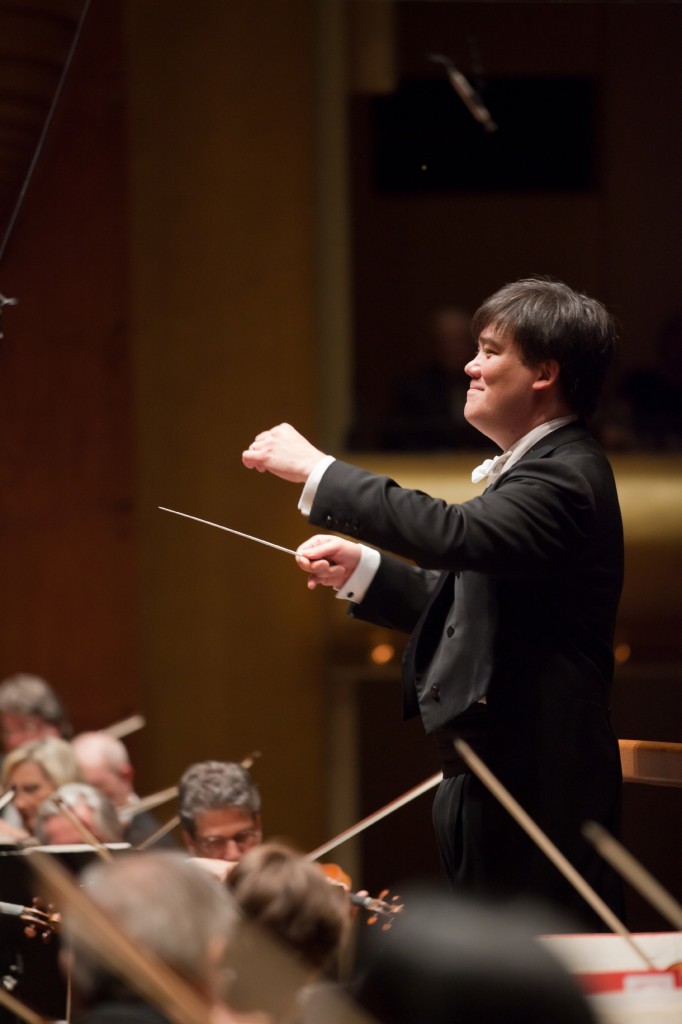Gilbert, Philharmonic wrap year with dark Sibelius, popular Mendelssohn and unexpected encore

Alan Gilbert conducted the New York Philharmonic in music of Sibelius Tuesday night. File photo: Chris Lee
In the week between Christmas and New Year’s Day, usually filled with concerts of traditional holiday music, the New York Philharmonic has inserted an usual program. There was nothing about each individual piece of music heard Tuesday night at David Geffen Hall that was out of the ordinary, but the combination and sequence made for an evening of oddball charm and substantial profundity.
Surely, somewhere, at sometime, there’s been a concert of Sibelius and Mendelssohn, but the exact combination of Sibelius’s Symphony No. 4 and Mendelssohn’s Violin Concerto—with Joshua Bell as soloist—may be a first. The sequence was unexpected too, with the symphony closing the first half and the Violin Concerto opening the second. And the icing on this upside-down cake comprised two short Sibelius orchestral works, the opening Swan of Tuonela and the finale, Finlandia.
Opening with meditative mystery and closing with extroverted energy is a standard and satisfying design, however. And the orchestra’s playing was at a rarefied level, enhanced by conductor Alan Gilbert’s deep, clear thinking about the pieces.
The Swan of Tuonela set the predominant tone, literally and figuratively. The orchestra’s sound was gorgeous; a rich, emulsified shimmer from which the individual voices of cello and English horn gradually emerged and subsided. Gilbert kept everything in a pool of sound so that the soloists pressed above the overall texture without ever standing apart from it; even the timpani was an unobtrusive pitched rumble that added depth and weight while never disrupting the flowing pulse.
The emphases in this and the symphony were one with Sibelius’ sound and his unique sense of time. These pieces don’t move through time like those of the Classical era, but establish a container of temporal stillness in which events move back and forth. Internal pulse is the key, and Gilbert and the orchestra produced a warm, palpable—but still light—one throughout the evening.
Gilbert’s approach in the symphony was deeply satisfying. It was astonishing to see in the program notes that the last time the Philharmonic played this great, profound work was in 1987 (under Erich Leinsdorf) but then it is also a strange piece of music. Beyond the metaphysical darkness of the composer contemplating what he believed was his impending death, the music spirals inward through a handful of small-scale structures.
Again, the sound of the orchestra was wonderful, and Gilbert managed a series of exceptionally subtle and fine dynamic modulations. His interpretive approach could be called dry, meaning he let Sibelius’ complex emotions speak for themselves, with slight and effective underlining of eccentricities like the short dance tune that separates itself from the main body of the orchestra in the Allegro molte vivace movement. In the last movement, the first appearance of the rising cello line presaged an inexorable surge in expression. The final A minor third had a grim resignation, one could see the composer’s granitic head, lips pursed.
The response to this notable performance was appreciative and polite. Bell was the clear draw for many in the sell-out crowd, which had listened patiently and attentively through the mysteries of the opening half.
Like the Violin Concerto itself, Bell offered no surprises. But his popularity, and that of the piece, is due to his excellence as a musician. He played with a singing tone, a light, almost vocalized, dynamic, and with a fluid agility that he pushed to some delightful extremes of tempo. The concerto speaks naturally to him, with it’s soulfulness, humor, and moments of stirring sadness. The standing ovation that followed was almost de rigeur, but not undeserved.
Gilbert and the orchestra accompanied Bell with verve, and played Finlandia with even greater energy and a big sound. The somatic pleasure the musicians found in making such wonderful music, pressed out to the audience.
Still, ending a concert with a fanfare, especially after beginning with an exploration of some uncommon dimensions of expression, is unsettling. But it made total sense as a segue to the pre-planned encore.
After the final applause, Gilbert returned wearing a Kansas City Royals uniform top, to pay off a World Series wager: the orchestra accompanied Joyce DiDonato, a Kansas City native, in “Kansas City” from Oklahoma Apparently, that was a one-nighter, but the pleasures of Sibelius and Mendelssohn will be around for a couple more evenings.
The New York Philharmonic and Joshua Bell play Sibelius and Mendelssohn at 7:30 p.m. Wednesday and 8 p.m. Saturday, January 2. nyphil.org